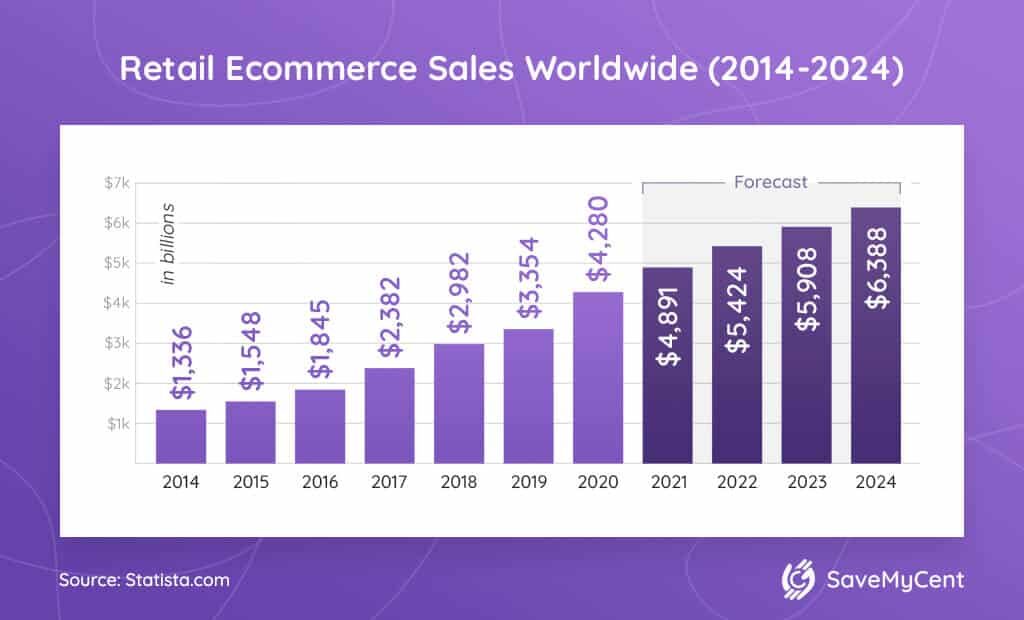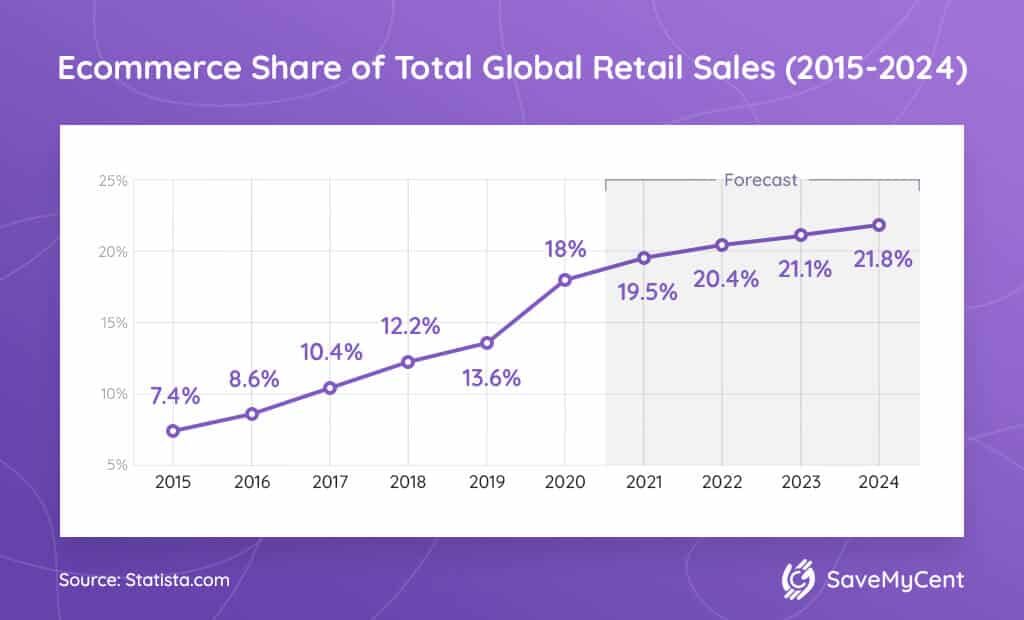Gone are the days when shopping online was just a niche alternative to regular shopping. Now some of the world’s biggest companies run solely online, and for many, the change feels as if it happened overnight. Let’s take a short break, look at some ecommerce statistics, and try to see where the ecommerce industry is headed.
How Many Ecommerce Stores Are There?
Estimates from previous years have put the number somewhere between 12 and 24 million ecommerce stores in the world. What is interesting is that most ecommerce stores are actually small, with just a small percentage of them earning more than $1,000 per year. As setting up an online store is easier for many than starting a physical store, many people resort to creating online stores as a way of making money, which is probably one of the reasons for the rapid growth of the ecommerce industry. In addition, the companies at the top are extending the boundaries of commerce, so it can sometimes be difficult to follow what’s happening in the industry.
It’s a fast-growing industry, it’s hard to pin down, and it won’t stop changing. That’s okay, as these fresh ecommerce facts and numbers are here to help.
1. What Are the Top 10 Ecommerce Sites?
(Statista)
The top 10 ecommerce companies in the world according to online traffic in 2020 were:
- Amazon
- eBay
- AliExpress
- Mercado Libre
- Rakuten
- Walmart
- JD
- Tmall
- Shopee
- Allegro
Ecommerce statistics show an interesting development on the market: the latest arrival to this list, Allegro, is the first European company to reach the top 10.
2. How Many People Shop Online?
(Statista)
If we take a look at online retail sales statistics, we can see that 2.14 billion people worldwide buy, browse, or compare products online in 2021. That means that for now, the ecommerce market has a size of one-quarter of the entire human population.
That is around half of the total number of internet users in the world, which is estimated to be around 4.66 billion people or almost 60% of the human population. As advances in technology give more people access to the internet, they also give them access to a vast market.
Online shopping growth statistics show that the number of online shoppers in the US is expected to reach 278.33 million in 2024.
3. How Much Does an Average Ecommerce Store Make?
(Jungle Scout)
While ecommerce is a growing business that’s becoming increasingly available to people all over the world, it is difficult to estimate the average profit for an ecommerce store. According to ecommerce statistics based on Amazon sellers, they make around $12,180 in sales per month.
However, that’s not the whole picture. A lot of their success depends on online marketing strategies, mobile website optimization, and the type of product they sell. It’s important to get a clear picture of the ecommerce market before dipping your toes in the water.
4. Is Amazon the Largest Online Retailer?
(Forbes, eMarketer)
In short: yes. Amazon is the world’s largest ecommerce company based both on revenue and traffic. In 2019, Amazon surpassed Walmart as the world’s largest online retailer, and it has only continued to grow since. In 2020, Amazon won a convincing victory on the market with an estimated 38.7% share of all US ecommerce sales.
5. How Many Ecommerce Stores Are There in the World?
(Digital Commerce 360)
Worldwide ecommerce statistics show that, according to calculations, there are 12-24 million ecommerce stores in the world. Since the industry is constantly growing, it is possible that global ecommerce, the actual number is even greater. However, only a fraction (650,000) generate more than $1,000 in annual sales.
6. How Much Is the Ecommerce Market Worth?

In 2021, the ecommerce market will reach a value of about $4.9 trillion in sales globally. With the increasing number of mobile device users in the world, their share in the ecommerce market, better worldwide Internet coverage, and other factors, the global ecommerce market is expected to reach $5.4 trillion in 2022.
However, after the coronavirus pandemic struck, we’ve seen dramatic changes in the entire commerce industry. Namely, ecommerce growth statistics projected growth of 16.5% in 2020.
The situation’s also driven more people to online shopping. Meaning, if we can buy it online and have it shipped or picked up safely, then that’s the new, preferred way of shopping. In global ecommerce statistics, that shows up as a change in the type of products we buy online. We mostly used to buy tech products and apparel online, but now, groceries are taking over our online shopping lists.
Naturally, a lot of the people who hadn’t bought much online before now have to acquire the habit. People are more wary in times of crisis, and as stats on online shopping show, there are a lot more people who are still getting familiar with online shopping. Therefore, for many people, the safest place to start shopping online is at the most well-known stores. The eMarketer report has shown that more people turn to the biggest ecommerce companies for service. This has brought us to an interesting ecommerce growth stat:
The growth rate of the top ecommerce companies in 2020 was 21.8%.
With these rates in mind, the next time you ask how big the ecommerce market is, it will most likely be even bigger.
7. How Much Shopping Is Done Online?

To wrap our minds around the size of the ecommerce market, we need to think in terms of ecommerce market share—ecommerce participated with 18% of all retail sales in 2020.
Out of each $100 spent on retail goods, $18 are spent online. The current pandemic might affect these numbers in the following years, as it accelerates nearly all forms of business into the online sphere. However, the current stats on global online shopping statistics show that the numbers for 2024 stand around 22%. However, as we see general retail sales numbers falling, and the ecommerce growth rate rising, we are yet to see the final result of this change.
Online shopping is not only about ordering things from the comfort of one’s home. It has gained a new dimension as people often take their phones to the store to compare prices and find deals. Online shopping statistics also show that 88% of shopping starts online, as people research the products on Amazon or Google before they head towards checkout, virtual or physical.
Last year, ecommerce exploded so much that people noticed even without percentages. Online shopping accounted for 21% of all retail sales in 2020 in the US, a strong rise compared to 16% 2019.
8. What Are the Biggest Ecommerce Companies?
(Forbes)
We’ve seen the list of the largest online retailers by traffic. Now it’s time to see how they rank according to revenue! Without further ado, these are the largest ecommerce companies by revenue: Amazon.com, JD.com, Suning Commerce Group, Apple, Walmart, Dell Technologies.
As we can see from digital commerce facts, the global ecommerce market is mostly divided between China and the US, with one only one of the largest online retailers in the world hailing from Europe. Interestingly enough, the distribution between countries on this list is quite similar to the traffic-based list.
9. How Big Is Ecommerce?
(eMarketer, Statista)
The ecommerce market size can be difficult to determine precisely, as it constantly grows. However, we can estimate its size by looking at the number of potential customers and the number of sales. The current number of customers comes down to about 2.14 billion people globally and those customers will be responsible for $4.9 trillion in sales this year.
10. What Is the Largest Ecommerce Company?
(VentureBeat, Amazon)
No matter whether we look at the largest online retailers by revenue or if we rank them by traffic, the number one position is still held by Amazon. With around 798,000 employees, and a total of $386.1 billion in net sales in 2020. According to its Q4 report, Amazon’s net sales in Q1 2021 are expected to reach somewhere between $100 billion and $106 billion. That would suggest a year-on-year growth between 33% and 40%.
Amazon, as the top ecommerce company, was responsible for 4.6% of total retail sales in 2020, both online and offline.
11. How Many Ecommerce Stores Are There in the United States?
(eMarketer, PipeCandy)
US ecommerce statistics put the number of online stores in the US at 1.3 million. But most ecommerce stores make less than $1 million in sales. The lion’s share of online trading is done by the top ecommerce companies in the USA.
12. What Is the State of Ecommerce in the US?
(MarketingCharts, The Washington Post)
Online shoppers statistics show that there are 230.5 million digital buyers in the US in 2021. That makes the US ecommerce market one of the largest in the world per capita. On top of that, the US ecommerce market size reached $709.78 billion in 2020, especially thanks to the growth rates of the top companies this year.
The five biggest online retailers in the US by share of US retail ecommerce sales in 2020 were Amazon, Walmart, eBay, Apple, and The HomeDepot. These companies, and Amazon in particular, were dominating the US ecommerce market.
Online shopping statistics by state are telling us another interesting story about our online shopping habits. While online shopping has been experiencing a boom in all states, the wealthier states are picking up the habit more quickly.
Also, online shopping has mostly flourished in urban areas due to the existing shipping infrastructure and the fact that many city dwellers don’t have cars to bring in the purchased products themselves.
However, more and more people in the US are resorting to ecommerce out of necessity this year. Because of that, we’re expecting to see online shopping becoming more prevalent outside of urban areas. The situation will likely force companies to improve their service and shipping infrastructure throughout the country.
13. What Percentage of Online Retailers Now Have M-commerce Websites?
(Medium)
Ecommerce stats say that by 2018, 85% of the Fortune 500 online retailers had released a shopping app. When it comes to all the ecommerce stores, it is difficult to come up with an exact number. Why is that?
While online purchasing stats predict that 72.9% of all retail ecommerce in 2021 will be done through mobile, other stats show that only 12% of shoppers say they find mobile shopping convenient. So, while many stores technically have a mobile presence, it is difficult to say how many are optimized for shopping on a mobile device and have actual market penetration.
But as m-commerce keeps growing, we can expect that having an m-commerce website will become as normal as apple pie.
Final Thoughts
Ecommerce is growing even faster than predicted. More people are getting the chance to buy and sell online, and all ecommerce sales statistics show the top companies breaking all records.
We’re buying online more and more, and the current situation is turning us towards ecommerce stores even faster. We are shopping using our computers, our phones, and our tablets; and even when we’re not shopping, we’re using them to compare prices or just pass the time.
To sum up:
Ecommerce is slowly becoming our new normal. And while traditional retail isn’t going anywhere yet, at the moment, ecommerce is a necessity.
Resources:


![How many Ecommerce Sites Are There [13 Pointed Questions Answered]](https://savemycent.com/wp-content/uploads/thumbs_dir/11-Online-Food-Ordering-Statistics-1-qbs6bl86abz2mnnnnzprgdt245cmn4bqhutekusjlo.jpg)
![How many Ecommerce Sites Are There [13 Pointed Questions Answered]](https://savemycent.com/wp-content/uploads/thumbs_dir/20-Ecommerce-Return-Rate-Statistics-1-qbs6nv0bigru7dty0aof0abpb8v54v1kulfm4wlid8.jpg)



![How to Get Free Clothes From Shein? [2024 Guide]](https://savemycent.com/wp-content/uploads/2023/09/How-to-Get-Free-Clothes-From-Shein-336x220.png)
